To excel in drone racing photography, you need to plan meticulously and choose the right gear. Research the race location to find ideal angles and understand the layout for capturing key moments. Use a high-quality drone with at least a 4K camera and guarantee it has gimbal stabilization for smooth footage. Set your shutter speed between 1/2000 and 1/4000 seconds to freeze motion, and shoot during early mornings or late afternoons for peak lighting. Don't forget post-processing techniques to enhance your images. By following these tips, you'll elevate your photography skills to capture thrilling racing action effectively. There's much more to explore!
Preparation and Planning
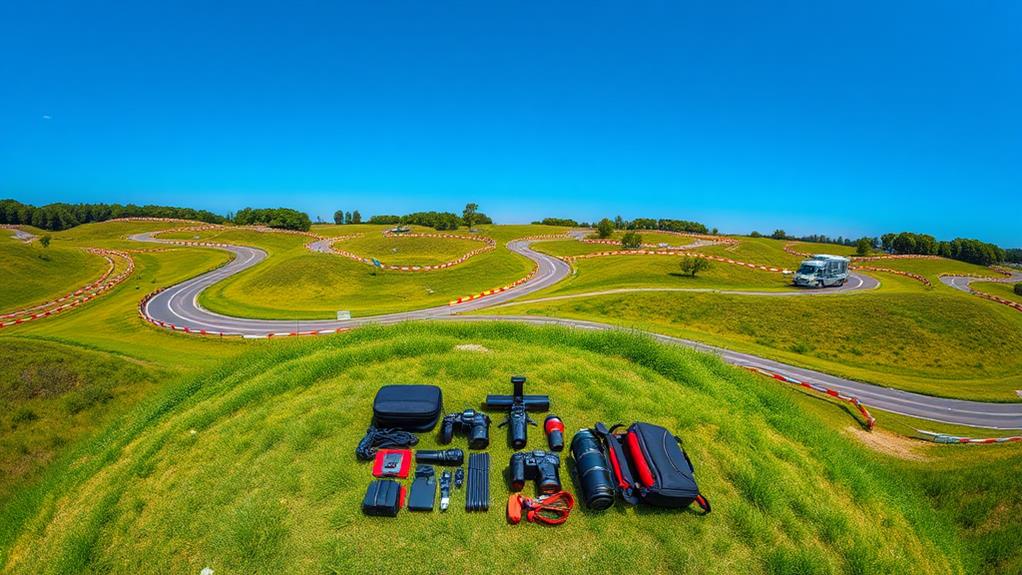
Preparation and planning are vital for capturing stunning drone racing photography. Start by conducting thorough research on the racing location using satellite views. This helps you identify ideal shooting angles and potential obstacles that might hinder your shots.
You'll want to plan your shoot schedule around the race timings, making sure you arrive early enough to set up and capture pre-race activities, like team preparations and fan engagement. Understanding the layout of the race can also enhance your photography, as it allows you to anticipate key moments during the event, contributing to your overall strategy for vital equipment.
Creating a shot list is important. Include key moments such as the start, mid-race action, and finish line celebrations to make certain you don't miss any highlights. Familiarizing yourself with the race layout and drone paths can also enhance your ability to anticipate the best spots for capturing dynamic action shots.
Don't forget to monitor weather conditions leading up to the event. Adverse weather can disrupt both racing and photography, so it's wise to keep an eye on forecasts and adjust your plans accordingly.
Essential Equipment
When it comes to drone racing photography, choosing the right equipment is vital for capturing stunning visuals. The fast-paced nature of racing requires drones with high-resolution cameras and robust stabilization features to keep up with quick movements.
You'll want to focus on camera selection tips, essential accessories, and the importance of stabilization equipment to guarantee your shots are sharp and smooth.
For instance, understanding camera specifications can greatly impact the quality of your images. Having the right gear not only enhances your photography but also elevates your overall racing experience.
Camera Selection Tips
Choosing the right camera for drone racing photography is vital for capturing the thrill of the action. Start with a high-quality camera that offers at least 4K video resolution. This guarantees you capture detailed and dynamic racing moments.
Additionally, understanding the importance of mastering camera settings can greatly enhance your shooting experience. Look for drones equipped with a gimbal stabilization system. This feature is important for smooth footage, especially during fast-paced movements and sharp turns.
When considering camera selection tips, think about using drones that support interchangeable cameras. This option allows for upgrades and lets you use specialized lenses tailored for different shooting scenarios.
Fast autofocus capabilities are another key feature to prioritize. A camera with quick focus will help you keep up with the rapid movements of racing drones, making sure your shots are sharp and clear.
Additionally, opt for drones with high frame rate capabilities, ideally 120fps or higher. This allows you to capture slow-motion footage, enhancing the excitement of racing events.
Essential Accessories Checklist
An essential accessories checklist can greatly enhance your drone racing photography experience. To capture those thrilling moments effectively, verify you have the right gear.
- High-Quality Drone: Invest in a drone equipped with a reliable camera capable of shooting in 4K resolution. This guarantees your footage is sharp and dynamic, vital for fast-paced drone racing events.
- Extra Batteries: Always carry extra batteries. Drone racing can be intense, and having additional power allows for extended shooting sessions without interruptions, making certain you don't miss any action.
- ND Filters: Utilizing ND (Neutral Density) filters is important for managing exposure and reducing glare. They help maintain the desired shutter speed, especially in bright conditions, resulting in smoother video capture.
Having these accessories at your disposal not only enhances your ability to take stunning photographs but also elevates the overall quality of your drone racing footage.
Stabilization Equipment Importance
Stabilization equipment is vital for capturing high-quality footage in drone racing photography. A high-quality gimbal is your best friend when it comes to maintaining a steady camera position. It reduces shakiness and guarantees smooth footage, even during fast-paced racing events.
Using a gimbal allows you to track racing drones effectively without losing stability or clarity in your shots.
In addition to gimbals, optical image stabilization (OIS) built into some cameras can greatly enhance your footage. OIS compensates for small vibrations and movements, making your videos look more professional.
Remember, a well-balanced drone setup, with proper weight distribution and calibration, is essential for achieving the best stabilization and maneuverability while filming.
To further improve your shots, consider employing ND filters alongside your stabilization equipment. These filters help manage exposure and shutter speed, resulting in clearer images during races.
By investing in the right stabilization tools and techniques, you'll elevate your drone racing photography to new heights, capturing dynamic moments with the clarity and quality that stand out.
Make stabilization a priority, and you'll see a marked difference in your final results.
Camera Settings
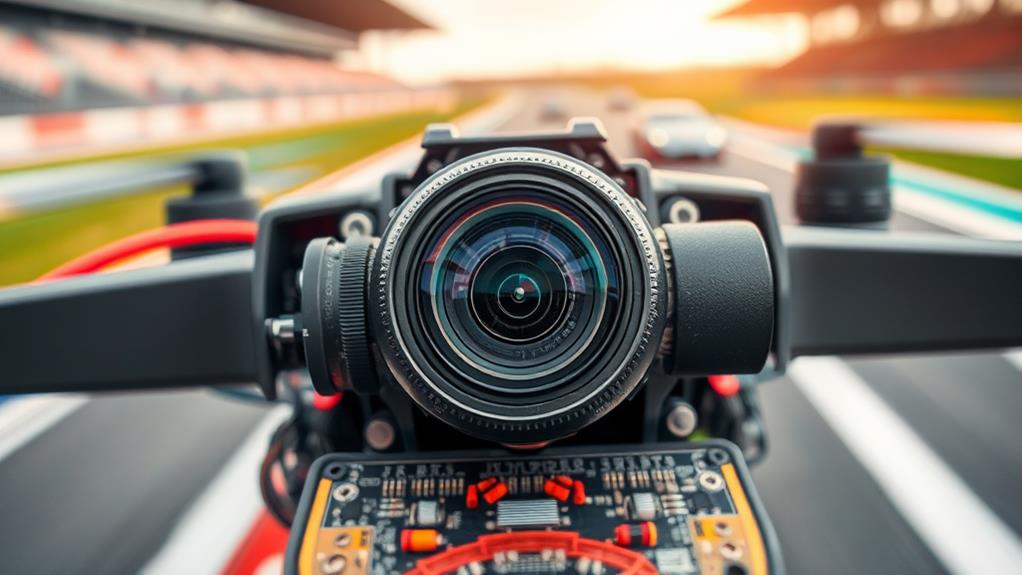
Capturing stunning shots of drone races hinges on mastering your camera settings. To guarantee you get sharp, dynamic images that highlight the action, focus on these essential settings:
- Shutter Speed: Set your shutter speed between 1/2000 to 1/4000 seconds. This range effectively freezes the fast-moving drones, minimizing motion blur and guaranteeing clarity in every frame.
- ISO Setting: Utilize a higher ISO setting, ideally between 800 and 1600. This adjustment helps maintain good exposure in varying lighting conditions, particularly useful in indoor or low-light environments.
- Aperture: Adjust your aperture to a wider setting, such as f/2.8 to f/4. This choice creates a shallow depth of field, isolating the drone from the background and enhancing focus on your subject.
Additionally, consider using continuous shooting mode to capture multiple frames per second. This increases your chances of getting that perfect shot as the drone maneuvers through the course.
Don't forget to experiment with white balance settings, opting for daylight or cloudy presets to accurately capture colors.
Master these settings, and you'll elevate your drone racing photography to new heights.
Ideal Shooting Locations
When scouting for the ideal shooting locations for drone racing photography, consider both scenic race tracks and urban landscapes.
Scenic tracks often provide well-defined courses with exciting obstacles, while urban settings can offer stunning backdrops that enhance your images.
Remember to evaluate each location for safety and compliance with local regulations, ensuring you capture the action without any legal concerns.
Scenic Race Tracks
At the heart of stunning drone racing photography are scenic race tracks that offer breathtaking backdrops. Capturing the excitement of flying drones against picturesque landscapes can elevate your drone pictures considerably.
Here are three ideal locations to contemplate:
- California Coastline: The scenic hills along the coastline provide a dramatic contrast between the ocean and rugged terrain, making for striking aerial views.
- Pacific Northwest Forests: Lush greenery and natural obstacles in this region create dynamic opportunities for capturing thrilling moments, such as sharp turns and jumps.
- Elevated Spectator Areas: Look for tracks with raised viewpoints. These spots allow you to take dramatic shots of the racing action below, showcasing both the beauty of the landscape and the skill of the pilots.
Timing your shots during key racing moments is essential. Focus on capturing tight turns or jumps, as these can result in enchanting images that highlight the thrilling nature of the race.
Urban Landscapes
Urban landscapes present a vibrant playground for drone racing photography, where towering buildings and unique architectural features create eye-catching backdrops. To capture stunning images, focus on popular urban spots like downtown areas. Here, the contrast between modern skyscrapers and historic buildings can result in striking compositions that elevate your photos.
Parks and open spaces within cities are also excellent locations for shooting. They provide greenery against urban cityscapes, allowing for controlled flying environments. This balance enhances the visual appeal of your images.
Incorporating landmarks such as bridges, monuments, and stadiums adds scale and context, making your drone racing photography more engaging and relatable.
Timing is essential; consider scheduling your shoots during events or peak hours. Capturing drones racing alongside bustling urban activities, like festivals or gatherings, adds excitement and dynamism to your photographs.
Action Capture Techniques
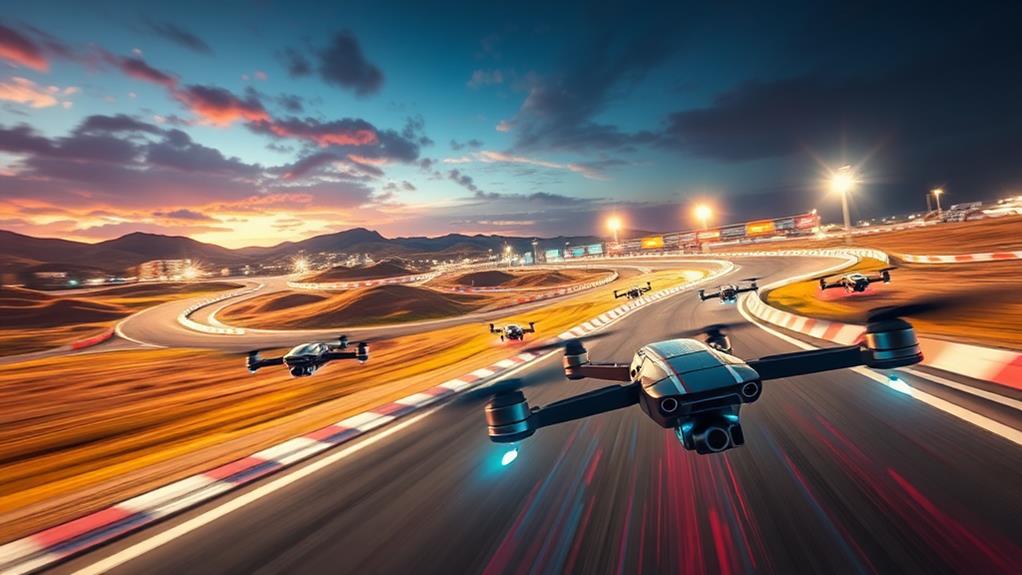
Capturing the thrill of drone racing demands a blend of skill and technique. To master action capture techniques, you'll want to focus on several key strategies that will enhance your photography while flying a drone.
- Utilize the "spray and pray" method: Continuously shoot during fast-paced action. This increases your chances of capturing that perfect moment when the drone zips by.
- Anticipate movement: Focus slightly in front of your target. This allows you to track fast-approaching subjects more effectively, and you'll find it easier to frame your shots.
- Experiment with angles: Try different vantage points, both low and high. Varied perspectives can add depth and excitement to your racing action shots.
In addition to these techniques, maintain a steady hand and use a gimbal for stability. This reduces the impact of rapid movements and guarantees clearer images.
Don't forget to adjust your camera settings; fast shutter speeds, typically between 1/2500 to 1/3200 seconds, will help freeze the action and minimize motion blur.
Lighting Considerations
Have you ever noticed how the right lighting can transform your drone racing photos? When you're out capturing those high-speed moments, lighting considerations are essential. The best times to shoot are early morning or late afternoon. During these hours, the light is softer, reducing harsh shadows that can hide important details.
Overcast days can also be advantageous, as they diffuse sunlight, providing even lighting without major highlights or shadows.
Using a polarizing filter can enhance your images further. This tool helps manage reflections and boosts color saturation, especially when photographing fast-moving drones against bright backgrounds.
To make certain you capture sharp images, you'll want to set your camera to fast shutter speeds, ideally between 1/1000 and 1/2000 seconds. This way, you freeze the action and capture those thrilling moments crisply.
Also, don't forget about your camera's ISO settings. Keeping it at a lower value can help reduce noise, particularly in bright conditions, leading to cleaner, sharper photos.
Post-Processing Tips
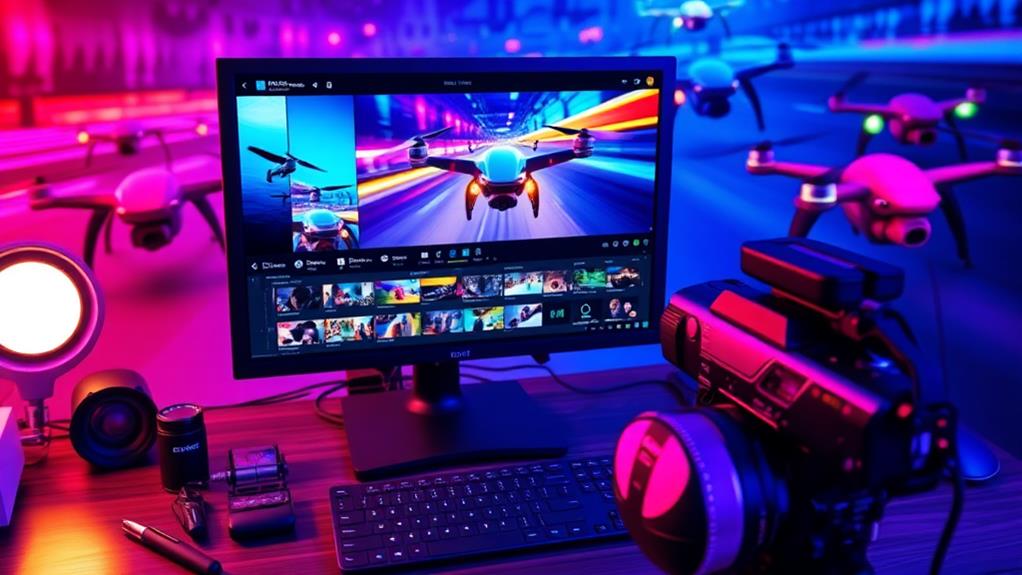
Post-processing can make a significant difference in your drone racing photography, turning good shots into stunning visuals.
To elevate your images, consider these essential post-processing tips:
- Color Grading: Use software like Adobe Lightroom or DaVinci Resolve to enhance the vibrancy and contrast of your images. This technique helps make colors pop and highlights the action in your shots.
- Stabilization Tools: Apply stabilization features in your editing software to smooth out any shaky footage. These tools can correct vibrations or rapid movements during races, resulting in cleaner, more professional-looking videos.
- Noise Reduction: Implement noise reduction techniques, especially for images taken in low light. Reducing noise improves overall image quality and gives your shots a polished, professional appearance.
Community Engagement
Engaging with the drone racing community can greatly enhance your photography skills and overall experience. By joining local groups like MultiGP, you can participate in events that allow you to learn directly from experienced pilots. This hands-on exposure can deepen your understanding of racing dynamics, which is vital for capturing compelling images.
Social media platforms are treasure troves for drone racing enthusiasts. You'll find groups dedicated to sharing tips, tricks, and insights that can elevate your photography. These communities often discuss common challenges, enabling you to learn innovative solutions from a diverse array of individuals.
Attending drone racing events not only provides an opportunity to capture dynamic shots but also allows you to network with pilots. These connections can lead to unique perspectives and behind-the-scenes experiences that enrich your photography portfolio.
Collaborating with fellow photographers at these races fosters a supportive environment where you can exchange resources and techniques.
Lastly, participating in online forums focused on drone racing photography can further enhance your skills, making community engagement an essential part of your growth as a photographer in this exciting field.
Conclusion
In drone racing photography, you're like a hawk soaring high above the action, capturing fleeting moments that tell a story. By preparing thoroughly, using the right equipment, and mastering your camera settings, you can elevate your shots from ordinary to extraordinary. Remember to engage with the community, as sharing experiences will enrich your journey. Embrace the thrill of the chase, and let your images reflect the excitement of the race, turning every frame into a dynamic piece of art.
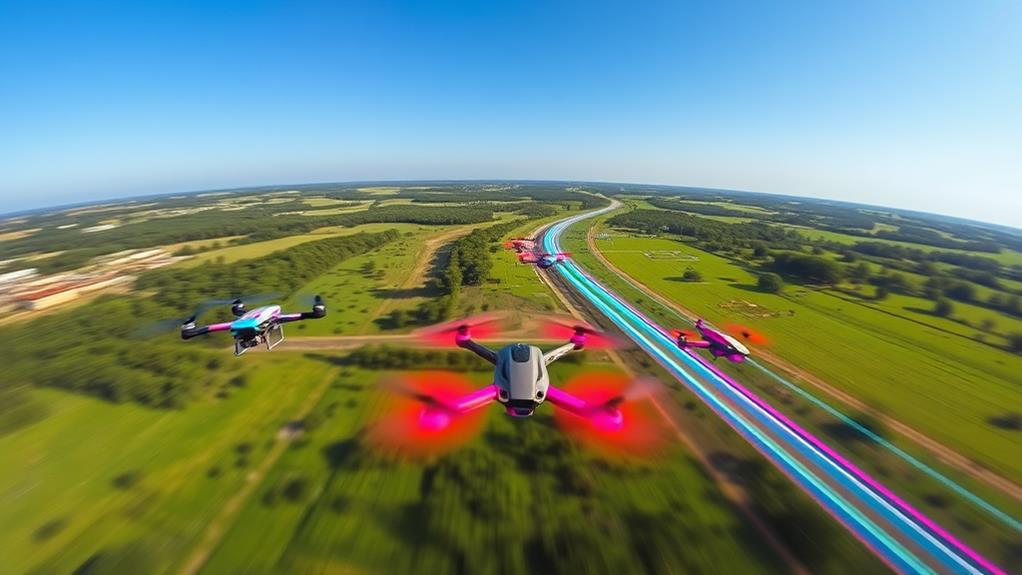
Leave a Reply